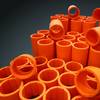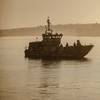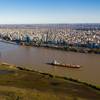By Larry Pearson
The various segments of the passenger vessel industry have undergone significant transformation in the last 12 months. It looks stronger as we head into the last six months of the year with ferries and charter yachts leading the way.
Frankly, a year ago the passenger vessel industry was in some disarray faced with developing a security plan to meet the Maritime Transportation Security Act of 2002 passed in Congress in wake of terrorism threats. Developing such a comprehensive plan by the end of 2003 proved to be an almost impossible task for an industry made up of mostly small boat owners.
Coming to the rescue was the industry's trade association the Passenger Vessel Association (PVA). They developed the PVA Industry Standard for Security of Passenger Vessels and Small Passenger Vessels. This plan was approved by the U.S. Coast Guard as an alternative to regulations required by the Maritime Transportation Security Act of 2002.
Member of PVA could access this plan, saving their individual companies thousands of dollars versus developing a plan that when done, may not pass Coast Guard muster. As a result membership in PVA has grown to an all-time high of 580 companies including 410 companies that operate U.S. flagged passenger vessels across the country.
"This major new growth in vessel members is a powerful endorsement of PVA's work on behalf of the passenger vessel industry," said Cornel Martin, 2004 PVA President.
Now passenger vessel operating companies can run their boats and develop plans for building new ones, free of this major obstacle.
Ferryboat Developments
For the past several years, the ferryboat segment of the passenger vessel industry has been the strongest by a large margin. Companies on both coasts have been building fast passenger vessels for a variety of ferry uses for a decade or more. Now another dimension has been added.
The year 2004 will be remembered as the year fast auto/passenger vessels first began operation in the U.S. It has been a year of unprecedented success with no less than four auto/passenger ferries beginning service. While a mainstay of the ferry industry in Europe, Australia and Asia, fast auto/passenger ferries have not been built for a number of reasons in the U.S. until now.
In 2004, two American flagged fast ferries and two carrying foreign flags are working in the U.S. The Alaskan Marine Highway System has put the Fairweather in service between the Alaskan ports of Juneau and Sitka. Built by Derecktor Shipyards, Bridgeport, Con., the 232-ft. by 60-ft. auto/passenger ferry can carry 32 vehicles and 250 passengers at 32 knots. Derecktor is building a second vessel for use in Prince William Sound.
Actually there has been one vehicle/passenger vessel operating from a U.S. port for several years. The Cat operates from Bar Harbor, Maine to Yarmouth, Novia Scotia. The original 91 m The Cat began operation in 1996 and was replaced with a 98-m model in 2002 that can travel at 42 plus knots. The new vessel is huge by any standard capable of holding 900 passengers and 240 vehicles. Both vessels were built by INCAT Tasmania of Australia.
Canadian American Transportation Systems (CATS) has put into service this month a huge auto/passenger ferry built by Austal Ships of Australia hat will run from Rochester to Toronto Canada. Capable of holding 750 passengers and 220 vehicles, the Spirit of Ontario was covered extensively in May Marine News.
A sister company of Austal Ships, Austal USA, recently built the Lake Express, a 192-ft. by 57 ft. auto/passenger ferry capable of holding 253 passengers and 34 vehicles. This vessel will inaugurate cross Lake Michigan service from Milwaukee, Wisc. to Muskegon, Mich.
"We think this size vessel will be very popular in the U.S.," said Chris Pemberton, general manager of Austal USA. Pemberton believes that once the vessel proves itself on Lake Michigan, there will be other areas that will see the need for this type of ferry.
Certainly with several fast vehicle/passenger ferries now in service, the opportunity is better than ever for other ferry systems who are evaluating fast ferries will be able to judge for themselves the applicability of this ferry concept for their operations and these evaluations will lead to more construction of these vessels.
The Caribbean has proven to be a lucrative market for small passenger ferries and tenders built by small (less than 50 employees) shipyards.
For example, Island Boats, Jeanerette, La. is finishing up the last of four 68-ft. passenger tenders to take passengers from the big cruise ships anchored offshore to the island of Belize and return to the ship.
Of catamaran design, these all-aluminum vessels can each hold 230 passengers and run at 25 knots. "These vessels are owned by Royal Caribbean Cruise Lines and were built to the same DNV standards as the big cruise ships themselves," said Myles Thomas, owner of Island Boats.
Thomas also reports he has a 72-ft. passenger vessel under construction for operation in Mexico.
Midship Marine, Harvey, La. also is doing well in the Mexican market. They have a three-vessel order for 125-ft. monohull ferries to make an 11-mile run between Playa Del Carman and Cozumel.
The vessels have capacity for 300 passengers on three decks. Propulsion is via a trio of Caterpillar 3412 diesels and there is a pair of 72 kW gensets on board…mainly to run several air conditioning units.
The first vessel was delivered in late May with the other two to follow later this year.
Excursion Boats Charter Vessels
There continues to be optimism in this segment as well, although far more ferries will be built than excursion/charter vessels. "We continue to be busy with a variety of both design and straight marine engineering projects," said Andy Lebet, vice president of DeJong & Lebet, Jacksonville, Fla.
Among the shipyards DeJong & Lebet do design and engineering work for is Keith Marine, Palatka, Fla. Right now Keith Marine is finishing up a new Sir Winston luxury dining yacht.
Winston Knauss typically builds a new vessel every 1-2 years, uses it in his charter yacht business in Ft. Lauderdale for a year or two and sells it when he takes delivery of a new vessel.
Keith Marine is also building a 160-ft., 600-passenger excursion boat for an undisclosed interest. DeJong & Lebet is doing the marine engineering.
The Freeport Shipbuilding Group is building the 125-ft. Solaris for June delivery. This vessel will also be operated by Freeport in the Ft. Walton Beach and Destin beach areas of the Florida Panhandle, just a few miles from the shipyard in Freeport, Fla. Capacity is 149 passengers and crew for this Subchapter T vessel.
A pair of Cat 3406 engines developing 340 hp each powers the Solaris. The three-deck vessel will have seating for 134 people on the main deck and additional seating on the second deck. A third deck for open for unobstructed sightseeing.
Freeport's next vessel will be a charter luxury yacht for New Orleans Steamboat Company. The company operates the famous steam powered sternwheeler Natchez from her downtown New Orleans dock and also runs the John James Audubon on regular cruises between the Aquarium and Audubon Zoo.
No size has been announced but NOSB President Gordon Stevens is anxious to get a 149-passenger luxury yacht is service in New Orleans. "With our dock location and our tourist infrastructure, (they operate the Gray Line bus franchise locally) we think this type of vessel is the right boat for New Orleans."
A company that continues to build luxury charter yachts for the wedding and other social and corporate event markets is Skipperliner of Lacrosse, Wisc. They are now working on their 17th Island Girl vessel. Every year, Skipperliner builds on of these 96- ft. long subchapter T vessels for their own yacht business and sells it at the end of the season.
Early this year Skipperliner delivered a 400-passenger subchapter K vessel and a 124-ft. "T" vessel to Pacific Avalon Yacht Charters of San Diego, Calif.
In the production schedule this year besides an Island Girl is another "T" vessel for Miami and at the end of the year a large "K" vessel will be delivered to an operator in Detroit. The company also builds a number of houseboats and other pleasure craft for the recreational market.
As noted above optimism is running high in both major segments of the passenger vessel industry.
Demand for fast passenger ferries, both car carriers and passenger only vessels, remain strong. Now with the security plans issue solved for the passenger vessel industry, there is a lot of interest in luxury charter yachts. Many owners are looking to the charter business as a growth option with excursion and sightseeing businesses mostly flat.
Featured videos

Inside the Electrified Truckable Tug

Inmarsat Enhances Service to Drive Digitalization

Tracking Foreign Vessels Working in the U.S. Jones Act Market
Subscribe for
Maritime Reporter E-News
Maritime Reporter E-News is the maritime industry's largest circulation and most authoritative ENews Service, delivered to your Email five times per week









